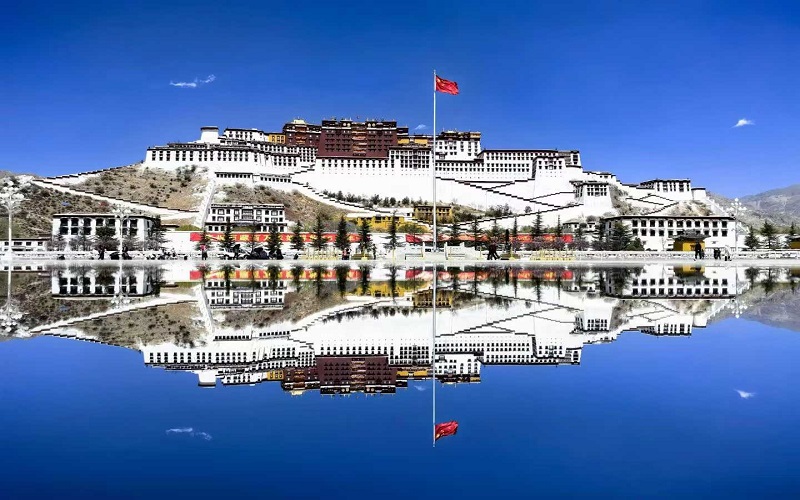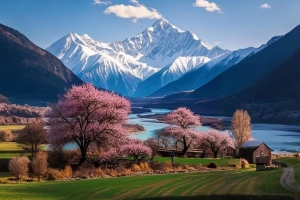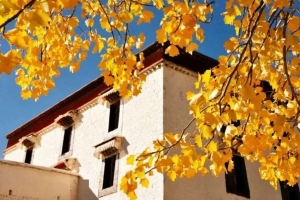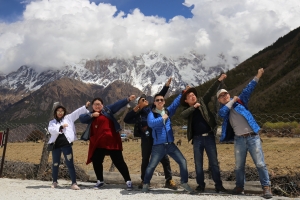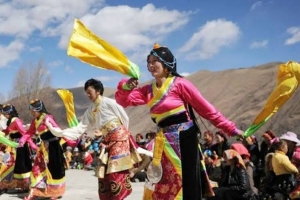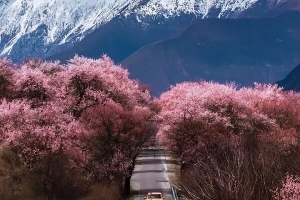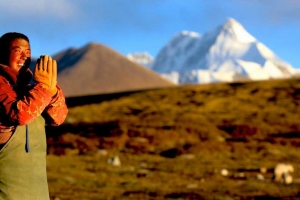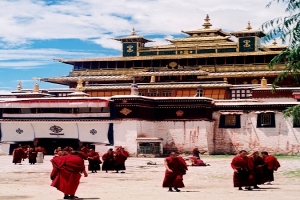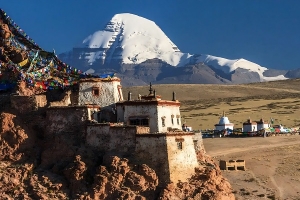Tibet, with its breathtaking landscapes, sacred Buddhist sites, and rich cultural tapestry, has long captivated the hearts of intrepid travelers. For visitors from the United States, an all-inclusive Tibet tour not only promises an immersive journey into one of the world’s most mystical regions but also a well-orchestrated travel experience that takes care of every detail. In this comprehensive guide, we explore multiple travel itineraries—from the bustling cities of Beijing, Shanghai, and Chengdu, as well as the enchanting gateway of Kathmandu—to Tibet, ensuring that every traveler finds a route that fits their interests and schedule. Choose your favorite travel route to Tibet, and then choose an all-inclusive tour package that is most suitable for American tourists to start your Tibet trip.
Itinerary Option 1: US to Beijing to Tibet
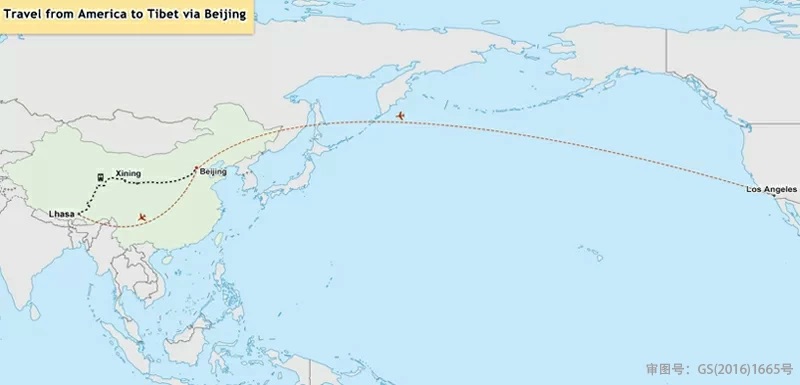
One popular and exciting itinerary begins in Beijing, China’s capital, before venturing into the heart of Tibet.
Flying from the US to Beijing
Travelers from the United States have numerous flight choices from major hubs such as New York, Los Angeles, Chicago, San Francisco, and Washington D.C. Renowned airlines including Philippine Airlines, Korean Air, and Singapore Airlines frequently operate these long-haul routes. By comparing flight schedules and booking in advance, you can secure competitive prices and a comfortable journey to Beijing.
Exploring Beijing’s Iconic Landmarks
Before venturing further west, take the opportunity to immerse yourself in Beijing’s rich historical and cultural heritage. With its blend of ancient palaces and modern marvels, Beijing is a destination in its own right. While visiting, be sure to include:
- The Forbidden City: Once home to emperors, this sprawling palace complex is a masterpiece of Chinese architecture and offers an immersive glimpse into imperial history.
- Tiananmen Square: This vast public space is steeped in historical significance and is a focal point of modern Chinese history.
- The Temple of Heaven: An iconic site where ancient Chinese emperors once prayed for a bountiful harvest.
- The Great Wall: A short excursion from the city brings you to one of the world’s most astonishing feats of engineering. Walking along the Wall offers a tangible connection to China’s long and storied past.
Journeying from Beijing to Lhasa
After savoring Beijing’s charm, the next leg of your journey takes you to Tibet’s capital, Lhasa. There are two primary methods to travel from Beijing to Lhasa:
- By Train: Embark on a scenic yet lengthy train ride that takes approximately 40 hours. Traveling by train not only gives you an opportunity to see the gradual transformation of landscapes—from the urban sprawl of Beijing to the vast, rugged terrains of Tibet—but also allows you to experience local life on board. Ticket prices vary, with options for hard sleeper seats priced around 720 yuan and soft sleeper seats costing approximately 1,144 yuan.
- By Air: For those who prefer speed and convenience, direct flights from Beijing to Lhasa are available. With flight durations ranging from 4 to 6 hours and twice-daily departures, this option is ideal for travelers eager to maximize their time exploring Tibet. Economy class fares typically range from 82 to 246 US dollars, offering affordability without compromising on comfort.
Itinerary Option 2: US to Shanghai to Tibet
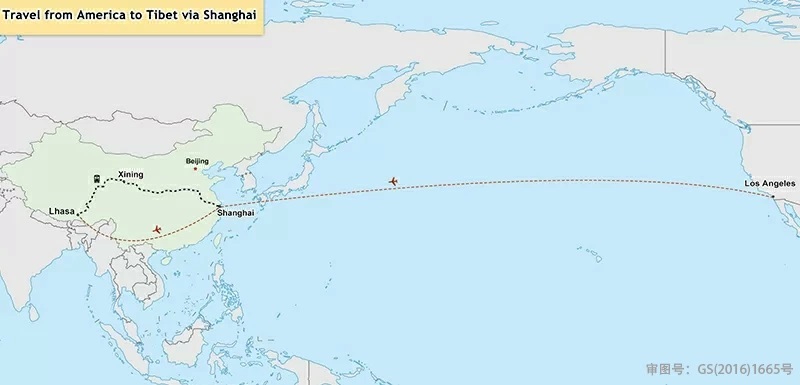
Another enticing option for American travelers is to begin your journey in Shanghai—a city that seamlessly blends historical charm with modern vibrancy—before heading to Tibet.
Connecting to Shanghai from the US
Numerous airlines operate routes from various American cities directly to Shanghai. Prominent carriers such as Air Canada, Air China, and EVA Air ensure a smooth connection between the US and Shanghai. By booking early, you might find attractive deals with fares frequently falling under 1,000 US dollars.
Discovering the Modern Charm of Shanghai
Shanghai is renowned for its cosmopolitan vibe and cutting-edge architecture. Upon arrival, take time to explore the city’s highlights:
- The Bund: This waterfront promenade offers stunning views of Shanghai’s skyline—a mix of historic colonial buildings and futuristic skyscrapers.
- Yu Garden: A classical Chinese garden that provides a serene escape from the city’s hustle and bustle.
- Jade Buddha Temple: Experience the tranquility and spirituality of this active temple, where modern visitors and devout worshipers alike find solace.
- Nanjing Road: One of the world’s busiest shopping streets, it offers everything from high-end boutiques to local markets.
Spend a couple of days exploring these attractions, soaking in the city’s vibrant culture, and sampling its renowned cuisine before you continue on your journey to Tibet.
Traveling from Shanghai to Tibet
Your next step is the transit from Shanghai to Lhasa. There are two convenient options:
- Air Travel: Flying from Shanghai to Lhasa is the quickest way to cover the approximately 8-hour journey. With direct flights available, you can quickly transition from the modernity of Shanghai to the ancient mystique of Tibet.
- Train Journey: If you have the luxury of time and prefer to enjoy scenic routes, consider the train. The rail journey from Shanghai to Lhasa is one of the longest, lasting nearly 47 hours. While it demands more patience, the experience is unique—allowing you to appreciate the dramatic changes in terrain and culture. Soft sleeper options are priced around 1,263 yuan, and hard sleeper options cost about 794 yuan, giving you a range of choices based on your comfort and budget preferences.
Itinerary Option 3: US to Chengdu to Tibet
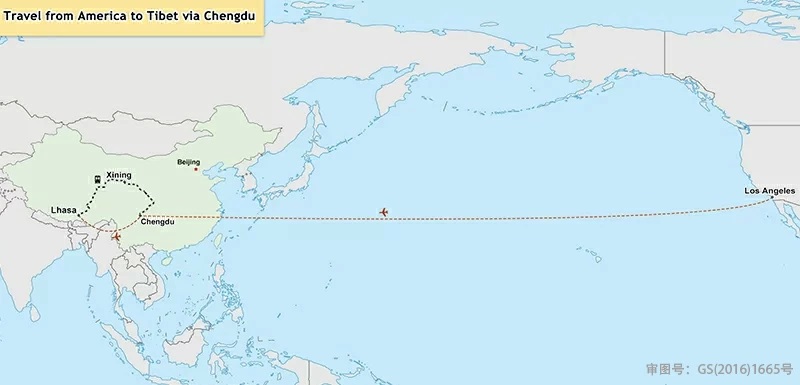
For those with a penchant for wildlife and a love for local culture, Chengdu serves as a gateway to both adorable pandas and the majestic lands of Tibet.
Reaching Chengdu from the United States
Flights from the United States to Chengdu often include a brief layover, with total travel time averaging around 19 hours. Major airlines such as China Southern Airlines, China Eastern Airlines, and Lufthansa provide routes from cities like Los Angeles, San Francisco, New York, and Seattle. Budget-conscious travelers can also take advantage of discounted fares, sometimes available for under 1,200 US dollars.
Encountering the Enchanting World of Pandas
Chengdu is famously home to the Chengdu Research Base of Giant Panda Breeding. This world-renowned facility is dedicated to the conservation of these endangered creatures, offering visitors an intimate look at the daily lives of pandas. The experience is a highlight for families and animal enthusiasts alike. Beyond the pandas, Chengdu’s culinary scene—celebrated for its spicy Sichuan dishes—and its relaxed atmosphere make it a favorite destination for travelers seeking both culture and nature.
Moving on from Chengdu to Tibet
When you’re ready to continue your adventure, Chengdu offers direct connections to Tibet:
- By Air: Flying from Chengdu to Lhasa is the most efficient option. With flight times averaging just 2 hours, you can swiftly transition from the playful ambiance of Chengdu to the mystical serenity of Tibet.
- By Train: Alternatively, if you’re inclined to enjoy the scenic journey, the train from Chengdu to Lhasa offers a picturesque and leisurely ride. Departing every other day, the train ride takes approximately 37 hours. This option is ideal if you want to immerse yourself in the natural beauty along the route.
Itinerary Option 4: US to Kathmandu and Overland into Tibet
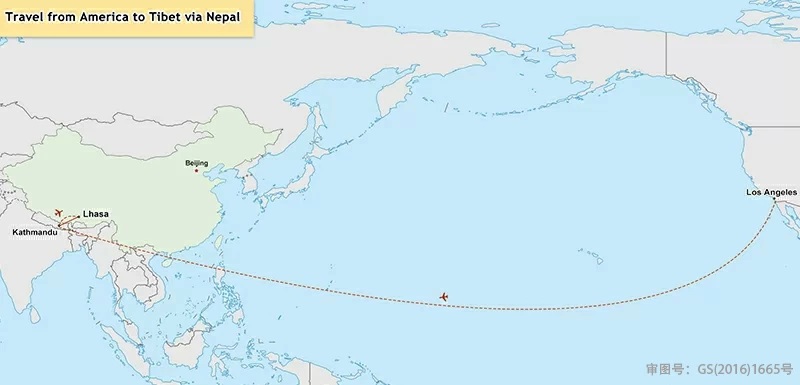
US to Kathmandu and Overland into Tibet
For the more adventurous traveler, beginning your journey in Kathmandu, Nepal, adds an extra layer of cultural immersion and a touch of Himalayan magic before entering Tibet.
Flights from the US to Kathmandu
Flights from the United States to Kathmandu typically range between 17 and 26 hours, depending on your departure city and the number of layovers. Airfares can vary from approximately 950 to 1,400 US dollars. Renowned carriers such as Qatar Airways, Indian Airlines, and China Eastern operate on these routes, ensuring comfortable travel and a variety of scheduling options. Booking in advance can often help you secure a more favorable fare.
A Glimpse of Kathmandu’s Cultural Heritage
Once you land in Kathmandu, take the time to explore this ancient city, which is a crossroads of cultures and traditions. Highlights of Kathmandu include:
- Pashupatinath Temple: One of the most important Hindu temples in the world, where spirituality and tradition are palpable.
- Kathmandu Durbar Square: A UNESCO World Heritage Site filled with ancient palaces, temples, and intricate carvings that tell stories of Nepal’s royal past.
- Boudhanath Stupa: An iconic Buddhist site that offers a peaceful atmosphere and stunning architectural beauty.
During your stay in Kathmandu, travel experts will assist you in securing the necessary documentation for your subsequent entry into Tibet, including group visas and travel permits.
Entering Tibet from Nepal
There are two main ways to venture from Kathmandu into Tibet:
- Overland Journey: For those with a spirit of adventure, the overland route from Kathmandu to Lhasa is an epic journey. After arriving in Kathmandu, you’ll travel by road to the Gyirong Port, where you will cross the border. Upon clearing customs, a local Tibetan guide will be waiting to escort you into Tibet. Due to the dramatic altitude changes, there is often an acclimatization stop in Gyirong County. From there, you can continue eastward, exploring key regions such as Dingri, the Everest Base Camp area, and Shigatse before finally arriving in Lhasa.
- Direct Flight: Alternatively, if you prefer to minimize transit time, you can opt for a direct flight from Kathmandu to Lhasa. The flight is relatively short—lasting approximately 90 minutes—and provides awe-inspiring aerial views of the Himalayan peaks, including a glimpse of Mount Everest if weather permits.
Arriving in Tibet, Join in One of The Best All-Inclusive Travel Packages
When you arrive in Tibet, you can choose one of the most popular Tibet travel packages. If you don’t like the Tibet itinerary I recommend for you, tell us your needs and we can also customize a Tibet travel package for you.
15 Day Mount Kailash Group Tour: Ngari+Lake Manasarovar+Lhasa+Yamdrok Lake+E.B.C.+Shigatse
Autumn in Tibet for 10 Days: Nyingchi+Lhasa+Yamdrok Lake+Ranwu Lake+Bomi+Namtso Lake+Qinghai-Tibet Railway
13-Day Tibet Tour on Flights and Soft Sleepers: Nyingchi+Lhasa+Everest+Yamdrok Lake+Shigatse+Namtso+Basomtso Lake
11 Days Ngari Discovery Tour: Lhasa + Manasarovar Lake+ Everest+ Mount Kailash + Shigatse + Yamdrok Lake
Tibet Classic 8-Day Tour: Lhasa + Shigatse + Yamdrok Lake + Everest Base Camp + Namtso
Frequently Asked Questions about Tibet Tours from USA
Here are answers to some common queries American travelers often have when planning a trip to Tibet:
What Travel Documents Do I Need?
For a smooth journey, ensure you have a valid passport, the appropriate Chinese visa (or Chinese group visa if traveling with a tour group), and a Tibet Travel Permit. If you are entering Tibet via Nepal, you will still require a group visa from the Chinese Embassy in Kathmandu, along with your travel permit. Additional permits may be necessary for trips to restricted areas such as Everest Base Camp or Mount Kailash. Your tour operator will assist in acquiring these documents.
When Should I Book My Tibet Tour?
It is advisable to book your Tibet tour at least 20 days in advance. This booking window allows enough time to process travel documents and secure accommodations and transportation. For specialized tours—such as those including visits to remote areas like Mount Kailash—consider booking at least 30 days ahead to allow for the additional documentation process.
What is the Best Time to Visit Tibet?
While Tibet is accessible year-round, the most favorable periods are from April to early June and from September to October. These months offer pleasant weather and clear skies, which are ideal for sightseeing and photography. The winter months, though less crowded and more budget-friendly, come with colder temperatures and may require extra preparation due to altitude challenges.
How Do I Prevent Altitude Sickness?
Altitude sickness is a common concern when traveling to regions above 3,500 meters. To mitigate its effects:
- Allow yourself a day or two to acclimate upon arrival in Lhasa.
- Stay hydrated and avoid overexertion during the first few days.
- Keep oxygen tanks or supplemental oxygen available—most reputable tour operators provide these as a precaution.
- Inform your guide immediately if you experience any severe symptoms.
What are Some Must-Visit Attractions in Tibet?
A journey to Tibet is incomplete without exploring its iconic landmarks:
- Potala Palace: The former winter residence of the Dalai Lama and a symbol of Tibetan Buddhism.
- Jokhang Temple and Barkhor Street: Located in the heart of Lhasa, these sites are pivotal to Tibetan spiritual life.
- Sera, Drepung, and Ganden Monasteries: Known as the “Great Three,” these monasteries offer deep insights into Tibetan monastic traditions.
- Namtso and Yamdrok Lakes: These high-altitude lakes are celebrated for their stunning natural beauty.
- Mount Everest Base Camp: For the adventurous, reaching the base camp is an unforgettable experience, with panoramic views of the world’s tallest peak.
How Long Should My Tibet Trip Be?
Most travelers find that an 8- to 10-day itinerary allows ample time to explore Lhasa, visit key cultural sites, and even include a trip to Everest Base Camp or other remote attractions. If you have limited time, shorter itineraries covering the essentials (such as Potala Palace, Jokhang Temple, and Barkhor Street) can be arranged. Alternatively, specialized tours focusing on trekking or cultural immersion may extend your stay to 15 days or more.
What Languages Will My Guide Speak?
In Tibet, you can expect bilingual guides who speak both Tibetan and English. Should you require assistance in another language, such as French or Japanese, it is important to communicate this preference ahead of time so that your travel advisor can make the necessary arrangements.
Embrace Your Tibetan Adventure
An all-inclusive Tibet travel package for American tourists offers more than just a journey—it’s an opportunity to explore a land steeped in mystery, spirituality, and natural grandeur. Your journey will take you through bustling metropolises filled with historical treasures and modern marvels, across expansive rail routes that reveal China’s diverse landscapes, and ultimately into the serene and sacred heart of Tibet. Along the way, expert tour operators ensure that every logistical detail—from securing visas and travel permits to providing bilingual guides and oxygen tanks—is meticulously handled, leaving you free to embrace the adventure with peace of mind.
Your Tibetan adventure is waiting. All you need to do is take the first step, and the road to unforgettable memories, cultural revelations, and natural splendor will unfold before you.

